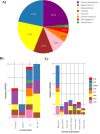miRNAs of Aedes aegypti (Linnaeus 1762) conserved in six orders of the class Insecta
- PMID: 34021209
- PMCID: PMC8139948
- DOI: 10.1038/s41598-021-90095-9
miRNAs of Aedes aegypti (Linnaeus 1762) conserved in six orders of the class Insecta
Abstract
Aedes aegypti L. is the most important vector of arboviruses such as dengue, Zika, chikungunya, Mayaro, and yellow fever, which impact millions of people's health per year. MicroRNA profile has been described in some mosquito species as being important for biological processes such as digestion of blood, oviposition, sexual differentiation, insecticide resistance, and pathogens dissemination. We identified the miRNAs of Ae. aegypti females, males and eggs of a reference insecticide susceptible strain New Orleans and compared them with those other insects to determine miRNA fingerprint by new-generation sequencing. The sequences were analyzed using data mining tools and categorization, followed by differential expression analysis and conservation with other insects. A total of 55 conserved miRNAs were identified, of which 34 were of holometabolous insects and 21 shared with hemimetabolous insects. Of these miRNAs, 32 had differential expression within the stages analyzed. Three predominant functions of miRNA were related to embryonic development regulation, metamorphosis, and basal functions. The findings of this research describe new information on Ae. aegypti physiology which could be useful for the development of new control strategies, particularly in mosquito development and metamorphosis processes.
Conflict of interest statement
The authors declare no competing interests.
Figures





Similar articles
-
miRNA Expression Response of Aedes aegypti (Linnaeus 1762) (Diptera: Culicidae) to Imidacloprid Exposure.Insects. 2025 Apr 27;16(5):460. doi: 10.3390/insects16050460. Insects. 2025. PMID: 40429173 Free PMC article.
-
Direct sequencing and expression analysis of a large number of miRNAs in Aedes aegypti and a multi-species survey of novel mosquito miRNAs.BMC Genomics. 2009 Dec 4;10:581. doi: 10.1186/1471-2164-10-581. BMC Genomics. 2009. PMID: 19961592 Free PMC article.
-
MicroRNAs of two medically important mosquito species: Aedes aegypti and Anopheles stephensi.Insect Mol Biol. 2015 Apr;24(2):240-52. doi: 10.1111/imb.12152. Epub 2014 Nov 24. Insect Mol Biol. 2015. PMID: 25420875 Free PMC article.
-
Presence of the point mutations Val1016Gly in the voltage-gated sodium channel detected in a single mosquito from Panama.Parasit Vectors. 2019 Jan 28;12(1):62. doi: 10.1186/s13071-019-3309-y. Parasit Vectors. 2019. PMID: 30691518 Free PMC article. Review.
-
miRNAs in Insects Infected by Animal and Plant Viruses.Viruses. 2018 Jul 3;10(7):354. doi: 10.3390/v10070354. Viruses. 2018. PMID: 29970868 Free PMC article. Review.
Cited by
-
microRNA Expression Dynamics in Culicoides sonorensis Biting Midges Following Blood-Feeding.Insects. 2023 Jul 6;14(7):611. doi: 10.3390/insects14070611. Insects. 2023. PMID: 37504617 Free PMC article.
-
miRNA Expression Response of Aedes aegypti (Linnaeus 1762) (Diptera: Culicidae) to Imidacloprid Exposure.Insects. 2025 Apr 27;16(5):460. doi: 10.3390/insects16050460. Insects. 2025. PMID: 40429173 Free PMC article.
-
Adaptive genomic signatures of globally invasive populations of the yellow fever mosquito Aedes aegypti.Nat Ecol Evol. 2025 Apr;9(4):652-671. doi: 10.1038/s41559-025-02643-5. Epub 2025 Mar 28. Nat Ecol Evol. 2025. PMID: 40155778 Free PMC article.
-
De Novo miRNAs from Anisopteromalus calandrae (Hymenoptera: Pteromalidae) Conserved in the Order Hymenoptera.Insects. 2024 Dec 20;15(12):1007. doi: 10.3390/insects15121007. Insects. 2024. PMID: 39769609 Free PMC article.
-
A double-agent microRNA regulates viral cross-kingdom infection in animals and plants.EMBO J. 2025 May;44(9):2446-2472. doi: 10.1038/s44318-025-00405-4. Epub 2025 Mar 5. EMBO J. 2025. PMID: 40045022 Free PMC article.
References
-
- Clements AN. The Biology of Mosquitoes. Development, Nutrition and Reproduction. Chapman & Hall; 1992. p. 509.
-
- Vilcinskas A. Insect Biotechnology. Springer; 2011. p. 268.
MeSH terms
Substances
LinkOut - more resources
Full Text Sources
Other Literature Sources

